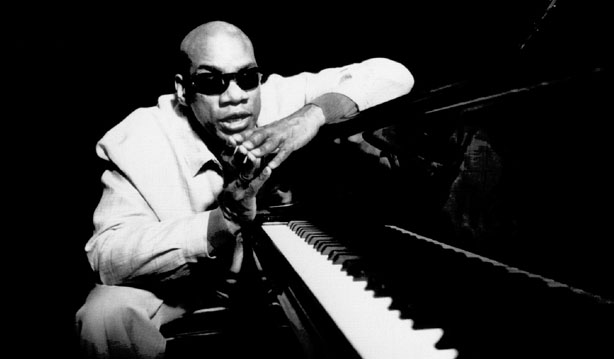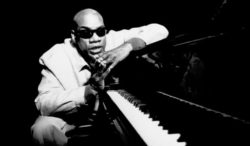Henry Butler
Blind since his birth in New Orleans, Henry Butler transcended life in the public housing projects to earn advanced music degrees and become a respected pianist and vocalist.

Courtesy of Henry Butler
Henry Butler. Unidentified
During his lifetime Henry Butler was considered by many to be the greatest living New Orleans pianist. Reared in New Orleans and schooled in Baton Rouge, Butler burnished his reputation by matching an unrivaled technical skill on the keyboard with a knack for informed improvisation that reflected his broad scholarly appreciation for influences across the spectrum of African-American and European music. Butler can be seen as the modern link in the chain of great New Orleans pianist–innovators that began with Louis Moreau Gottschalk and extended through Jelly Roll Morton, Professor “Fess” Longhair, and James Booker.
Blind since his birth in New Orleans in 1948, Butler spent most of his early years in the Calliope housing project and started piano on a neighbor’s instrument at age six. At that time, he began attending the Louisiana State School for the Blind in Baton Rouge. He found it a wonderful atmosphere for learning music; he studied baritone saxophone, valve trombone, and drums, and he arranged copious amounts of music in addition to mastering the piano. At fourteen, he began performing professionally in Baton Rouge clubs with a variety of bands, including his music teacher’s cover band. “We were called The Notables,” Butler told Offbeat magazine in 1998. “That band had a horn section with three saxophones, and we’d play some light jazz and lots of rhythm and blues (R&B) and New Orleans stuff.”
After high school, Butler entered Southern University in Baton Rouge, where he majored in voice. “There were very few braille scores available back then for piano and other keyboard instruments,” Butler told Offbeat about switching his major from piano to voice.
“Also, because of the logistics of transposing braille scores, it was just taking me too long to learn piano music. And, of course, there were few teachers who knew how to teach a blind pianist, especially in a college curriculum. Vocal music was much easier to sight read, and would make it much more possible for me to work out a college program. … As a voice major, I studied the American classical literature, European literature, French art song, Italian art song, German lieder, opera, oratorio. And I always knew I would use the influences of whatever I was learning in the music I was making my living with.”
At Southern, he also studied with clarinetist Alvin Batiste, perhaps his most formative teacher. Batiste exposed him to cultural differences across the full range of Western music and schooled him on the value of improvisation from a learned structure instead of just from instinct. Batiste arranged for him to obtain a National Endowment for the Arts grant that enabled him to work with George Duke, who had just become pianist for the legendary saxophonist Cannonball Adderley. Butler pursued a master’s degree at Michigan State University and studied in successive summers with pianist/composers Harold Mabern and Roland Hanna.
Butler moved back to New Orleans in 1974. He played local clubs—such as Tyler’s and Lu and Charlie’s—took in the sounds of such master pianists as James Booker, and had at least one long lesson with the dean of New Orleans R&B pianists, Professor Longhair. In 1980 he moved to Los Angeles, California, where a meeting with bassist Charlie Haden led to Butler’s first recording as a leader: 1986’s Fivin’ Around on MCA/Impulse, with Billy Higgins on drums. A second MCA/Impulse release, The Village, had Jack DeJohnette and Ron Carter as accompaniment. Thus, Butler’s first two albums found him playing with the cream of the modern jazz crop.
Butler moved to New York in 1987 to solidify his jazz credentials, then relocated to the Midwest in 1990 to teach at Eastern Illinois University for six years. “I’ve been teaching both voice and piano for most of my adult life,” he explains. “It’s something that I enjoy, and something that is really needed.”
After he returned to his native for New Orleans for ten years, Butler’s house was heavily damaged by Hurricane Katrina in 2005, and he found residence first in Boulder, Colorado, then in Denver, and finally in Brooklyn, New York, where he lived from 2009 until his death in 2018.
Later in life Butler continued to play modern jazz, but his emphasis shifted to blues and New Orleans R&B. He produced duet albums with Corey Harris and New Orleans guitarist Snooks Eaglin (Vu-Du Menz and Blues after Sunset, respectively) as well as two of his own virtuoso displays of solo piano (Blues & More, Volume I, and PiaNOLA Live). PiaNOLA Live includes both “Tipitina,” the trademark tune of Professor Longhair, and the composition “North American Idiosyncrasies” by Alvin Batiste, who had arranged for Butler to meet—and learn from—Fess during his student’s formative years. Butler was one of the great solo pianists. He could play shuffles and stride piano in the manner of the great traditionalists, as well as Cuban-inflected New Orleans R&B à la Longhair or Dr. John. But in Butler’s playing there was always an undercurrent of suppressed energy that erupted from time to time in an explosive funk interlude or a brazenly outside harmony culled from his mastery of modern jazz.
Topping it all was a ferocious baritone voice with a two-and-a- half-octave range. The whole gamut of African expression, from spirituals to modern jazz, informed it, as did Butler’s study of European art song, a genre he began performing in high school. As Dr. John put it, “He plays the piano like Art Tatum, but when he starts singing, he sounds like Paul Robeson.”
Butler died on July 2, 2018.
